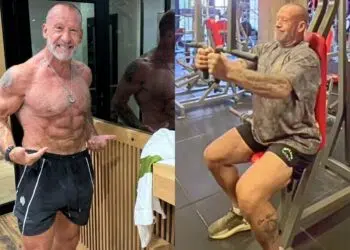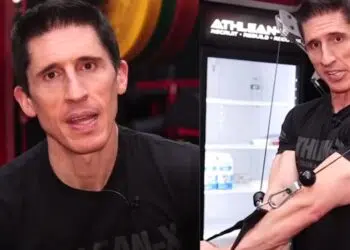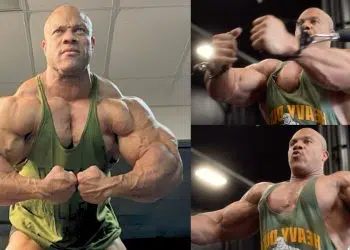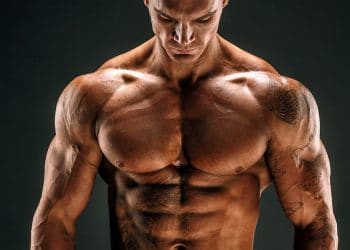Monday is national chest-training day, and that invariably means bench presses. The bench press can be an effective pec-builder, but it’s not the only way to sculpt the chest you’ve always dreamed of.
In fact, while it may be a blasphemous thing to say, for some lifters, the bench press is not a good pec exercise. Long arms, narrow shoulders, and a shallow chest can mean the bench press produces minimal chest growth and can even cause shoulder pain and injuries.
The good news is that the bench press is no law that says you have to do bench presses, and there are plenty of other exercises you can do instead.
Try dumbbell bench presses if using a barbell bothers your shoulders, or weighted push-ups or dips if you train at home.
In this article, we reveal why and how to do high to low crossovers, so you can add another great exercise to your chest workouts.
High to Low Crossovers – Muscles Worked
High to low crossovers are an isolation exercise. That’s because the movement happens at one joint. As such, this exercise doesn’t involve a lot of muscles, but the muscles it does involve get a very effective workout!
Level Up Your Fitness: Join our 💪 strong community in Fitness Volt Newsletter. Get daily inspiration, expert-backed workouts, nutrition tips, the latest in strength sports, and the support you need to reach your goals. Subscribe for free!
These muscles are:
Pectoralis major
Known as the pecs for short, this large fan-shaped muscle makes up the bulk of your chest. The pecs consist of three sets of fibers, called heads:
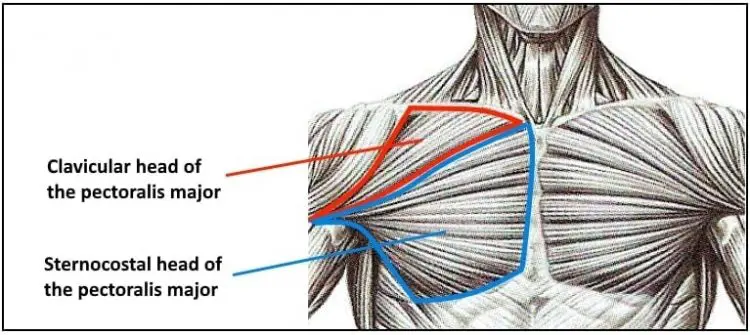
- Clavicular head – upper pecs
- Sternal head – mid-pecs
- Abdominal/costal head – lower pecs
The high-to-low action of this exercise means you hit all three pec heads, but the lower pecs are the most active as the tension is greatest at the bottom of each rep, when your hands are lowest.
Deltoids
The deltoids are your shoulder muscles. Like the pecs, there are three heads:
- Anterior – front
- Medial – middle
- Posterior – rear
All three deltoids are involved in high to low crossovers, but the anterior head works the hardest as it works with your pecs to flex your shoulders. The remaining two heads work primarily as stabilizers.
Serratus anterior
The serratus anterior is a small muscle located to the side of your upper chest. Looking not unlike a serrated knife blade, this muscle is responsible for holding your scapulae or shoulder blades flat against your ribs. With no bench for support, the serratus anterior muscles are very active during high to low crossovers.
Core
Core is the collective name for the muscles of your midsection. These include the rectus abdominis, obliques, and transverse abdominis. These muscles contract isometrically or statically to support your lumbar spine and prevent unwanted movement. It’s impossible to do high to low crossovers without engaging your core.
Biceps and triceps
Your elbows should not move much during high to low crossovers, and that means you’ll need to engage your biceps and triceps to keep them rigid. While these muscles are working during this exercise, the load on them is pretty low, so you may not feel them contracting much. If you DO feel your arms working, you might be using them too much, taking work away from your pecs.
How to Do High to Low Crossovers
Get more from high to low crossovers while keeping your risk of injury to a minimum by following these guidelines:
- Attach D-shaped handles to a cable crossover machine. Adjust the pulleys so they’re at shoulder level or above.
- Hold a handle in each hand and stand in the middle of the cable crossover machine. Take a step forward and adopt a split stance.
- Brace your core and bend your elbows slightly to keep the stress off your joints. Keep your arms rigid throughout.
- With your hands out at shoulder height, bring your arms in and down so your hands meet in front of your hips. Pause for a second in this most contracted position.
- Open your hands and raise your arms, getting a good stretch in your pecs.
- Continue for the prescribed number of reps.
Pro Tips:
- Use a light to medium weight and perform medium to high reps for best results, e.g., 12-20+ reps per set.
- Imagine you are “hugging a tree” to perform the arm movement correctly.
- Do not lean forward or start using your arms to lift the weight, both of which takes stress off the target muscles.
- Use a full range of motion, moving from a stretched position to bringing your hands together in front of your hips.
- Use a slow, controlled movement to maximize your mind-muscle connection and make this exercise even more effective.
- Relax your hands; gripping too tightly can increase biceps and triceps activation, taking work away from the target muscles (the pecs).
High to Low Crossovers – Benefits and Drawbacks
Not sure if high to low crossovers deserve a place in your workouts? Consider these benefits and then decide!
An effective way to isolate your chest
As chest isolation exercises go, the high to low crossover is a very effective option. There is near-constant tension on your pecs, and you can fine-tune the movement by adjusting the angle of your arms. Plus, with the right load, you won’t need to rely on your triceps to lift the weight.
Very shoulder-friendly
Unlike exercises performed on a bench, the high to low cable crossover allows your shoulder joints and scapulae to move naturally. This means less joint stress and a more shoulder-friendly workout. If dumbbell flyes or bench presses hurt your shoulders, this exercise is a great alternative.
Easy to learn
High to low crossovers are a very straightforward exercise that even beginners can master within a few minutes. It doesn’t matter if you perform your reps using a lightly different arm angle or range of motion, provided you do the basic movement correctly.
Great for drop sets
Want to pump your pecs to the max? Try some cable crossover drop sets. Rep out to failure, reduce the weight by 10-15%, and then rep out again. On hitting failure, lower the weight again and crank out a few more reps. Drop sets are an excellent intensity-boosting training technique that can stimulate greater muscle growth.
While high to low crossovers are a mostly beneficial exercise, there are also a few drawbacks to consider:
Not a good strength exercise
Using heavy weights for low reps doesn’t work with high to low crossovers. Use too much weight, and your body will probably move backward instead of your arms moving forward. Exercises like bench presses and machine chest presses are better for building strength.
Equipment availability
While most commercial gyms have a cable crossover machine, some do not, and you probably won’t have access to this machine if you work out at home. That said, there are some great cable machines designed specifically for home use.
7 High to Low Crossover Variations and Alternatives
High to Low Crossovers are a highly effective chest isolation exercise, but that doesn’t mean you need to do it all the time. There are several variations and alternatives you can use to keep your workouts productive and interesting:
1. Horizontal crossover
While there is nothing wrong with high to low crossovers, some lifters won’t want to work their lower pecs. After all, if any muscle becomes overdeveloped, it will affect your overall aesthetics. This variation targets your inner mid-pecs and not your upper or lower chest.
Steps:
- Attach D-shaped handles to a cable crossover machine. Adjust the pulleys so they’re level with your chest.
- Hold a handle in each hand and stand in the middle of the cable crossover machine. Take a step forward and adopt a split stance.
- With your arms extended to the sides, bring them in so they meet at chest height. Your arms should remain parallel to the floor throughout.
- Pause for a second in this most contracted position.
- Open your arms and get a good stretch in your pecs.
- Continue for the prescribed number of reps.
Muscles targeted:
- Primary: Pectoralis major.
- Secondary: Anterior deltoids.
Benefits:
- A shoulder-friendly chest exercise.
- More constant muscle tension than flat bench dumbbell flyes.
- An excellent way to target specific portions of your chest for balanced muscle growth.
Tips:
- Use a split stance for stability.
- Brace your core and keep your torso upright throughout.
- Maintain a slight bend in your elbows to minimize joint stress.
2. Low to high crossover
Where the high to low crossover tends to emphasize the lower chest, the low to high variation hits the upper chest a little more. This may be useful if you don’t like incline dumbbell flyes or incline bench presses but still want to work your upper pecs.
Steps:
- Attach D-shaped handles to a cable crossover machine. Adjust the pulleys so they’re level with your hips.
- Hold a handle in each hand and stand in the middle of the cable crossover machine. Take a step forward and adopt a split stance.
- With your arms extended to the sides, bring them forward and up so they meet at chest height.
- Pause for a second in this most contracted position.
- Open your hands and lower your arms, getting a good stretch in your pecs.
- Continue for the prescribed number of reps.
Muscles targeted:
- Primary: Pectoralis major.
- Secondary: Anterior deltoids.
Benefits:
- An effective upper chest exercise.
- Lots of tension on your pecs at the midpoint of each rep.
- Very shoulder-friendly.
Tips:
- Use a slow, controlled tempo to make this exercise as effective as possible.
- Do not use your elbows to help lift the weights, as doing so takes tension off your chest.
- This exercise works best when done for medium to high reps with light to moderate weights.
3. Flat bench cable fly
One of the drawbacks of high to low cable crossovers is that you are limited by the strength of your core and your ability to stabilize your body. You are the bench! But you can also do crossovers with an actual bench, which means you’ll be able to handle heavier loads more comfortably.
Level Up Your Fitness: Join our 💪 strong community in Fitness Volt Newsletter. Get daily inspiration, expert-backed workouts, nutrition tips, the latest in strength sports, and the support you need to reach your goals. Subscribe for free!
Steps:
- Place a flat bench in the middle of a cable crossover machine.
- Attach D-shaped handles to the lowest pulleys.
- Take a handle in each hand. Sit and then lie on the bench with your arms outstretched, elbows slightly bent but rigid.
- Bring your arms forward and up so your hands meet above your chest.
- Open your arms to get a good stretch in your chest, and repeat.
Muscles targeted:
- Primary: Pectoralis major.
- Secondary: Anterior deltoids.
Benefits:
- Less stability and core strength are required, so you can use heavier weights.
- An effective chest isolation exercise.
- An excellent alternative to standing crossovers.
Tips:
- Keep your elbows slightly bent but rigid throughout, and don’t turn this exercise into a pressing movement.
- Try doing this exercise with your feet elevated to increase chest activation.
- You can also do this exercise using an incline bench to target your upper chest:
4. Pec deck
While high to low crossovers are a pretty basic chest exercise, the pec deck machine is even simpler. The machine guides your movements, leaving you free to focus on pushing your pecs to their limit. If you want to isolate and fully fatigue your chest, the pec deck is an excellent option. However, it’s not as shoulder-friendly as high to low crossovers.
Steps:
- Adjust the seat so that, when you sit on it and hold the handles, your arms are bent to 90 degrees, and your elbows are roughly level with your mid-chest.
- Grip the handles and brace your core.
- Squeeze your elbows together so they meet in front of your chest.
- Open your arms, get a stretch in your pecs, and repeat.
Muscles targeted:
- Primary: Pectoralis major.
- Secondary: Anterior deltoids.
Benefits:
- A very straightforward exercise that’s perfect for beginners.
- A great exercise for drop sets.
- An excellent way to isolate the pecs.
Tips:
- Focus on pushing with your elbows and not your hands to maximize chest engagement.
- Adjust your range of motion according to your flexibility and shoulder health.
- Use the foot lever (if available) to make it easier to get into the correct starting position without hyperextending your shoulders.
5. Chest fly machine
The chest fly machine is often confused with the pec deck, but, in reality, they’re two different exercises. The main variance between the pec deck and the chest fly is the length of the levers involved.
With bent arms, the pec deck uses very short levers, while the straight-arm chest machine fly uses longer levers. While this difference doesn’t make one exercise better than the other, it does change the feel of the exercises, and some people prefer one over the other.
Steps:
- Adjust the seat so that your shoulders are roughly level with the handles. Sit down and grip the handles with a neutral or palms-in grip. Your arms should be extended out to the sides, with a slight bend in your elbows.
- Contract your chest and squeeze the handles forward and together. Do NOT turn the flying motion into a press; keep your elbows slightly bent but rigid.
- Open your arms and return to the starting position, getting a good stretch in your chest.
- Continue for the required number of reps.
Muscles targeted:
- Primary: Pectoralis major.
- Secondary: Anterior deltoids.
Benefits:
- A very beginner-friendly exercise.
- An excellent exercise for drop sets.
- Some users find this exercise more comfortable than pec decks.
Tips:
- Pause at the mid-point of each rep to maximize pec recruitment.
- Use a slightly lower seat height to emphasize your upper pecs or a slightly higher seat high to work your lower pecs more.
- Squeeze your pecs at the midpoint of each rep to maximize muscle engagement.
6. Isometric chest fly
Not everyone has access to a cable crossover. Even if you have a well-equipped home gym, a cable machine may be beyond your means. The good news is that you can get a similarly effective albeit isometric workout using nothing more than a stability or Swiss ball.
Steps:
- Hold a stability ball between your palms and extend your arms so your hands are level with your shoulders. Your elbows should be slightly bent but rigid.
- Brace your core and pull your shoulders down and back.
- Without holding your breath, squeeze your arms together as hard as possible for 10-30 seconds.
- Relax, release, rest, and repeat!
Muscles targeted:
- Primary: Pectoralis major.
- Secondary: Anterior deltoids.
Benefits:
- VERY joint-friendly.
- No special equipment required.
- An excellent way to pre or post-exhaust your pecs.
Tips:
- You can also do this exercise by pressing with your elbows and forearms, like an isometric pec deck.
- No stability ball? No problem! Just press the palms of your hands together instead.
- Do short, hard presses, e.g., ten seconds, to build strength, or longer, less intense presses, e.g., 30 seconds, to develop muscular endurance and size.
7. Decline dumbbell fly
The decline dumbbell fly is a freeweight version of high to low crossovers. It targets the same muscles, but the strength curve is in reverse. With cable crossovers, the movement is easiest when your arms are apart and gets harder as they come together. In contrast, dumbbell flys are hardest when your arms are apart and get easier as your hands get closer.
This does not make one exercise better than the other but does suggest both movements deserve a place in your workouts.
Steps:
- Set a decline bench to 10-20 degrees. Lie on the bench with your hips uppermost. Hold a dumbbell in each hand above your chest so your arms are vertical. Your palms should face inward, i.e., a neutral grip.
- Keeping a slight bend in your elbows, open your arms and lower the weights out to the side. Get a good stretch in your chest but do not hyperextend your shoulders.
- Squeeze the weights back up and repeat.
Muscles targeted:
- Primary: Pectoralis major.
- Secondary: Anterior deltoids.
Benefits:
- An accessible exercise, even for home gym users.
- An effective way to target your lower pecs.
- A viable alternative to high to low cable crossovers.
Tips:
- Pause at the bottom of each rep to increase time under tension and make the exercise more effective.
- Keep your hands 12-18 inches apart at the top of each rep to increase muscle engagement.
- Experiment with the angle of the bench to see what works best for you.
High to Low Crossover FAQs
Do you have a question about high to low crossovers or chest training in general? That’s okay because we’ve got the answers!
1. How many reps and sets of high to low cable crossovers should I do?
Until quite recently, most bodybuilders believed that they had to train in the 6-12 rep range to build muscle, and training outside this range made their workouts less effective. More recent research indicates that you can build muscle with almost any number of reps, provided you take your sets close to failure (1). This means you can do as many as 20-30 reps per set and still build muscle.
However, while high to low cable crossovers are compatible with high reps and light weights, they don’t work well for low reps and heavy weights. Heavy loads will make it all but impossible to do the exercise correctly, i.e., without cheating. For many lifters, this means 12-20 reps is the ideal workable rep range for high to low crossovers.
In terms of sets, if you can’t fatigue your muscles in 3-4, you are either resting too long between efforts or not getting close enough to failure.
2. Are high to low cable crossovers safe?
High to low crossovers are a very safe exercise. For starters, you can train to failure without worrying about dropping weights on your face. As such, you don’t need a spotter for this pec-pumper.
Also, because your scapulae and shoulders are free to move, there is very little stress on your joints, provided you don’t reach back too far.
High to low crossovers and easy to learn, which makes them an excellent option for beginners.
This all adds up to a safe exercise that, when performed correctly, has a low injury risk for most lifters.
3. Will high to low crossovers build muscle?
Many fitness experts believe that compound exercises such as bench presses are better for building muscle than isolated movements like high to low crossovers. The latter, they suggest, is better for muscle shaping.
However, studies suggest that compound and isolation exercises can be equally effective for hypertrophy (2). Also, the concept of muscle shaping is a myth, as muscle shape is a genetic trait and cannot be modified.
So, if you want bigger pecs, the high to low cable crossover is a good choice, but compound moves like push-ups and chest presses are also effective.
4. How many times a week should I train my chest?
Muscle groups tend to respond best to two workouts per week, e.g., Monday and Thursday. This provides a good balance between training and recovery. One workout per week can work, but you’ll need to cram all your sets and exercises into that session, so it’s going to be a long, draining workout. Two medium-sized workouts are usually more convenient and practical than one long one.
You could also train each muscle three times per week, but that is too much for most people and could lead to overtraining.
5. Will high to low crossovers improve my chest separation and definition?
Muscle definition is largely a matter of your body composition. If you want your muscles to be defined, your body fat percentage must be relatively low. How low depends on how defined you want to be.
Sadly, not even high to low cable crossovers will melt fat from your chest. Instead, you need to get a grip on your diet and lose body fat so the details of your muscles show through your skin.
Pec definition, like six-pack abs, is as much a result of your diet as your training. That said, high to low cable crossovers won’t hurt your quest for a more defined chest.
Wrapping Up
High to low crossovers are one of many excellent exercises you can use to build your chest. Like most cable exercises, they’re easy to learn, very safe, and provide an intense mid-rep contraction which is great for building muscle. You can also use them for drop sets, which are a fantastic way to raise the intensity of your workouts.
Are they the BEST chest exercise? Probably not. But that’s no reason to dismiss them and start looking for an even better exercise. That’s because the best exercise does not exist.
All exercises have value, and the best movement is the one that suits and works for you.
So, try high to low cable crossovers, but don’t feel you have to do them if they don’t match your goals. They’re just one of many exercises you can use to build the body of your dreams.
References:
- Lasevicius T, Ugrinowitsch C, Schoenfeld BJ, Roschel H, Tavares LD, De Souza EO, Laurentino G, Tricoli V. Effects of different intensities of resistance training with equated volume load on muscle strength and hypertrophy. Eur J Sport Sci. 2018 Jul;18(6):772-780. doi: 10.1080/17461391.2018.1450898. Epub 2018 Mar 22. PMID: 29564973. https://pubmed.ncbi.nlm.nih.gov/29564973/
- Gentil P, Soares S, Bottaro M. Single vs. Multi-Joint Resistance Exercises: Effects on Muscle Strength and Hypertrophy. Asian J Sports Med. 2015 Jun;6(2):e24057. doi: 10.5812/asjsm.24057. Epub 2015 Jun 22. PMID: 26446291; PMCID: PMC4592763. https://www.ncbi.nlm.nih.gov/pmc/articles/PMC4592763/
Interested in measuring your progress? Check out our strength standards for Bench Press, Push Ups, Cable Fly, and more.



